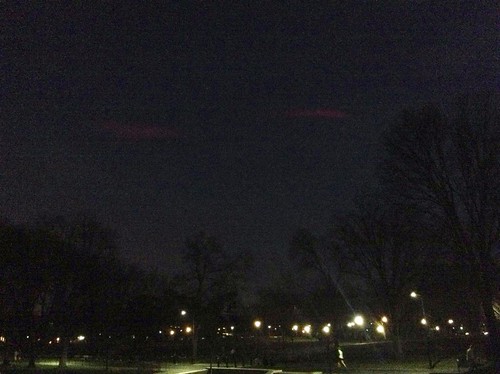NASA Wallops launched two sounding rockets last night, each releasing a cloud of red lithium vapor into the upper atmosphere to test ground-based observation techniques for space phenomena.
Launch was at 5:50 PM. I didn’t have time to get home and set up a camera, so I walked over to Lincoln Memorial to see if the rockets would be visible. The sky was cloudy, though, and the Memorial floodlights drowned out all but the brightest stars. T-0 came and went and I saw nothing. (Somewhat embarassingly I had told a bystander to watch for it too.)
Dejected, I walked off, but took one last look at the southeastern sky — and there they were, two masses of glowing red mist. I thought at first it was just some patchy cloud catching the last rays of sunset, but they brightened as the sun faded, till they stood out starkly against the night.
It had been too cloudy to see the rockets themselves (small rail-launched Terrier sounding rockets) but gas release was unmistakable. I called Amy to let her know the red glow was visible, and she did see it from the roof of our parking garage. Over the next few minutes the red intensified, then gradually faded and dispersed. I headed home, posting my photos with NASA Wallops’ designated hashtag: #rocketsredglare.
Also see this timelapse from YouTube user Carson000321 in Columbia, MD:
Not quite as spectacular as ATREX had been, but still something of a show. The next major NASA Wallops launch I’m eagerly anticipating is the Orbital Antares commercial test flight, tentatively scheduled for this March (according to the current launch schedule). The rocket should be very visible up and down the east coast if the sky is clear.
